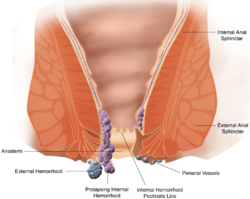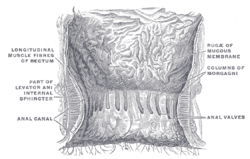Pectinate line
From Wikipedia, the free encyclopedia
| Pectinate line | |
|---|---|
 | |
| Pectinate line labeled at bottom center. | |
 | |
| The interior of the anal cami and lower part of the rectum, showing the columns of Morgagni and the anal valves between their lower ends. (Pectinate line visible but not labeled.) | |
| Latin | Linea pectinata, linea anocutanea |
The pectinate line (dentate line) is a line which divides the upper 2/3s and lower 1/3 of the anal canal. Developmentally, this line represents the hindgut-proctodeum junction.
It is an important anatomical landmark, and several distinctions can be made based upon the location of a structure relative to this line:
| Distinction | Above pectinate line | Below pectinate line |
| destination of lymph drainage | internal iliac lymph nodes,[1] inferior mesenteric lymph nodes[2] (pararectal lymph nodes), | superficial inguinal lymph nodes (below Hilton's white line)[3] |
| epithelium | columnar epithelium (as is most of the digestive tract - the line represents the end of the part of the body derived from the hindgut) | stratified squamous epithelium, non-keratinized (until Hilton's white line, where the anal verge becomes continuous with the perianal skin containing keratinized epithelium.) |
| embryological origin | endoderm | ectoderm |
| artery | superior rectal artery | middle and inferior rectal arteries |
| vein | superior rectal vein | middle and inferior rectal veins |
| hemorrhoids classification | internal hemorrhoids (not painful) | external hemorrhoids (painful) |
| nerves | inferior hypogastric plexus | inferior rectal nerves |
Additional images
-
Microscopic cross section of the anorectal junction.
-

Anatomy of the anus and rectum
-

Coronal section of rectum and anal canal.
References
External links
- Pectinate+line at eMedicine Dictionary
- pelvis at The Anatomy Lesson by Wesley Norman (Georgetown University) (rectum)
| |||||||||||||||||||||||||||||||||||||||||||||||||||
This article is issued from Wikipedia. The text is available under the Creative Commons Attribution/Share Alike; additional terms may apply for the media files.
